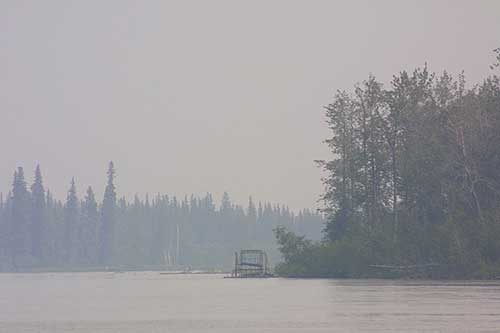 by Ned Rozell July 24, 2004
East of Delta Junction, the Gerstle River had overflowed its banks, slicing through a gravel road and flooding a portion of the Tanana Valley State Forest. Farther north, a wildfire was turning thousands of acres of spruce trees and tundra in the forest to smoke and ash.  Photograph by Ned Rozell...
"Like a lot of glacial streams, the Gerstle flushes lots of gravel down its bed at high flow, so much that the river is almost higher than the surrounding ground," said Al Edgren, the state forester for the region who was monitoring both the flood and the nearby forest fire. "Since the surrounding area is almost lower than the river, there's a big sheet of water across the state forest land." The water had cut through a 14.5-mile road in six places, Edgren said. Flows of glacial water up to six-feet deep on the road prevented people from traveling to a Native community at Healy Lake. "Right now, they'll have to fly in," Edgren said. In 2004, Fairbanks had the second warmest June in 100 years of weather records, according to the Alaska Climate Research Center. Records were also topped at one of the longest monitored glaciers in Alaska. A weather station at 4,855 feet next to Gulkana Glacier recorded new high temperature readings for both May and June, according to Rod March, a glaciologist with the U.S. Geological Survey. The glacier's weather station recorded an average daily temperature of 39.5 degrees F for May (compared to the normal reading of 34.2 and the previous record of 39.1) and 50.9 degrees for June (compared to the normal reading of 41.5 and the old record of 47.1). The thermometer next to the glacier that registered all-time highs this summer has been recording since 1967. The rise in temperature also showed in the increased flow of Phelan Creek, which drains the glacier, March said. The June flow readings taken from a gauge on the stream showed it at the highest levels since technicians installed the instrument in the late 1960s. Floods during the warmest part of summer will be more common if Alaska continues to experience record high temperatures, and the washing out of roads might be another consequence of a changing climate. Adding to the strangeness is that while some glacial rivers spill over their banks, rivers nearby will shrink at the same time. "The Tanana could be at
flood stage while at the same time the Chena could be experiencing
record low flows," said Ed Plumb, a hydrologist with the
National Weather Service.
This column is provided as
a public service by the Geophysical
Institute, University of Alaska Fairbanks, in cooperation
with the UAF research community. Ned Rozell (e-mail)
is a science writer at the institute.
|